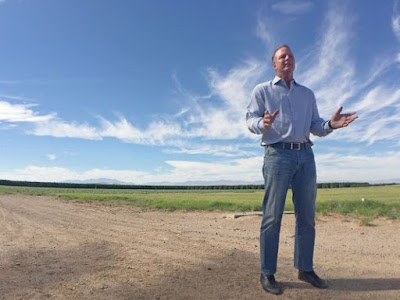Why the BLM’s decision on the Cadiz project was the right one
Guest commentary
By Adell L. Amos and Sam Kalen
San Bernardino County Sun
Officials at the Bureau of Land Management have to make a lot of sensitive decisions. But their recent decision that a 43-mile, 7-foot diameter groundwater pipeline does not further the purpose of an 1875 railroad right-of-way should not be controversial. It is as simple as this — a water pipeline project is something different than a railroad.
Despite tremendous pressure to shoehorn a massive groundwater pipeline into a century-old railroad right-of-way, the BLM made a rational decision that the proposal was not in furtherance of the railroad’s purpose. Scott Slater, president and General Counsel of Cadiz Inc., asserts that BLM should rescind that decision.
Cadiz Inc., a Los-Angeles based company, wants to build a pipeline to carry groundwater from a fragile Mojave Desert aquifer to southern California. It’s the kind of project that calls out for careful and considered decision-making by public officials. The project could have a significant impact on sensitive desert habitat and the interests of tribes, local communities and national parks nearby. In fact, such careful review was completed under state law, though it is now undergoing appeal by project opponents.
If BLM had sided with Cadiz and determined that this new water project furthered a railroad purpose, then the project could proceed without federal environmental reviews, tribal consultations and interagency coordination that would otherwise be required.
Not surprisingly, Cadiz had a profound interest in trying to convince the BLM that its proposal — which is about transporting valuable water to thirsty urban areas in southern California — was actually about advancing the railroad’s purpose.
Ultimately, the BLM made a straightforward and common-sense determination that the water pipeline does not further a railroad purpose. This decision ensures, if the project goes forward, it will be subject to appropriate public review. Instead of criticism, the BLM ought to be commended for its responsible management of public resources in the face of tremendous pressure from private interests.
To move forward now, Cadiz will be asked to do what any private developer on federal public land is asked to do — participate in an open, public process under federal law that evaluates the various impacts of the project. That is not a controversial notion in the least. Developers on public lands, though they might prefer to avoid it, engage in this kind of review all the time.
Many opponents of the Cadiz Project worry that this attempt to locate the project in an existing railroad right-of-way was a clever sleight of hand designed to circumvent an open and public evaluation of the impacts and consequences of this project under federal law. To the extent that these concerns about the impacts are unfounded, the federal review process will bear that out.
Perhaps Cadiz worries that the federal review will shed light on what some believe to be faulty scientific assumptions about the recharge rate of the aquifer, or the irreversible environmental harm that could come from pumping 1-2 million acre feet of precious desert groundwater for 50 years, or the impact to historic, natural and cultural resources including the Mojave National Preserve, the lower 48’s third-largest national park unit. More than a decade ago Cadiz proposed a very similar project and the federal environmental review process revealed many of these concerns. Many of these concerns are also at issue in the appeal challenging the state review process.
In the end, BLM exercised sound professional judgment in a climate where water is becoming increasingly scarce and highly valuable. Some estimates put the price of the water associated with the Cadiz project at $1-2 billion. BLM is not required to advance private interests to achieve maximum profit for their investors. Rather, BLM exists to manage, for multiple and often competing purposes, the public lands consistent with all applicable laws. In choosing this course, the BLM carried out its mandate with integrity toward the process and acted as a responsible steward of the public resources it is entrusted to manage.
Adell L. Amos is Associate Dean for Academic Affairs at the University of Oregon School of Law. She is a former Deputy Solicitor for Land and Water Resources at the Department of Interior.
Sam Kalen is co-director of the Center for Law and Energy Resources in the Rockies at the University of Wyoming School of Law. He is a former Special Assistant for the Solicitor’s Office at the Department of the Interior.






